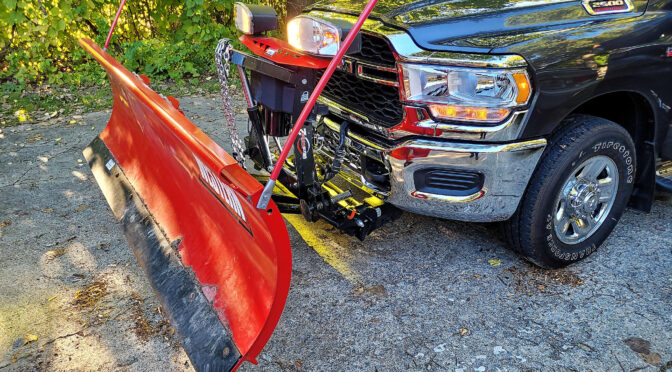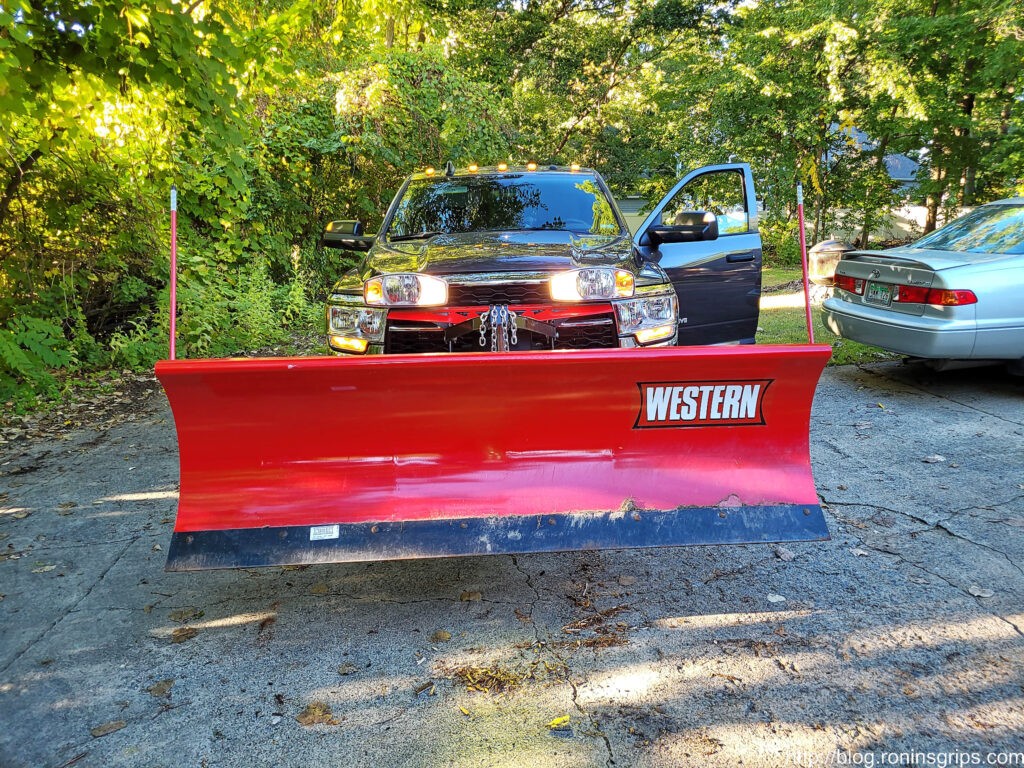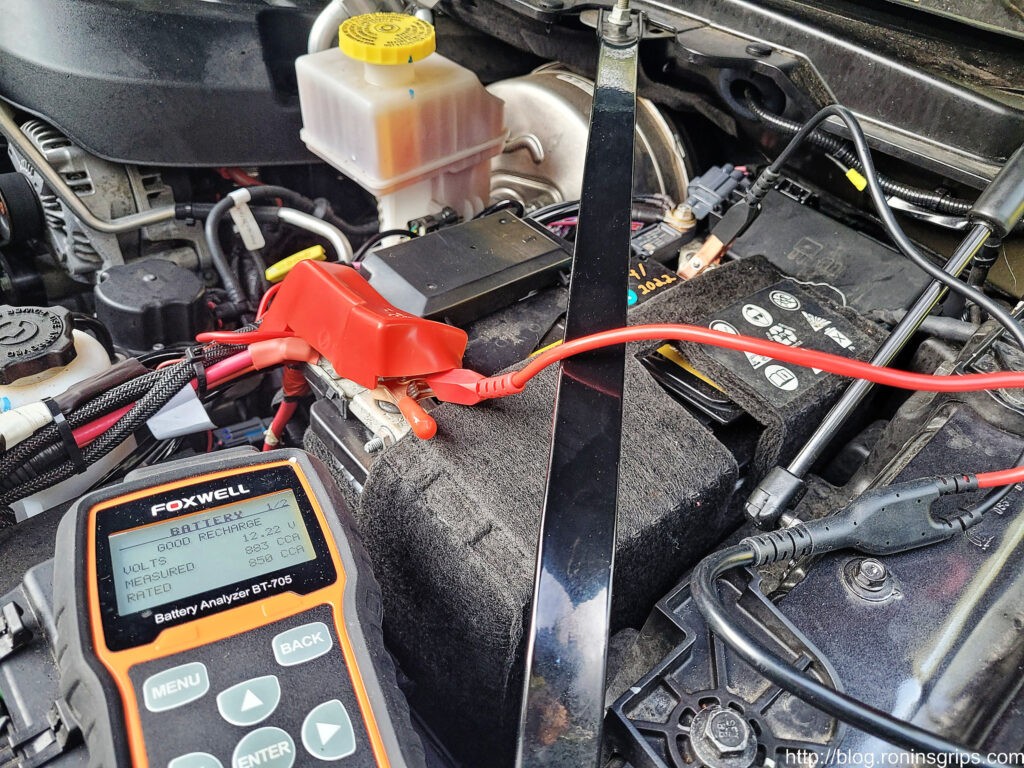My one big disappointment with my 2021 Ram 2500 with the 6.4 Hemi is it’s lack of sufficient electrical power to run my Western Pro Plow 2 snow plow and the heater on full – yeah, that combo has issues. My truck came with the Snow Chief option package that was supposed to make it snow plow ready with a 220 amp alternator plus anti-spin rear differential, aux switches, LED clearance lamps, LT275/70R/18E tires on 18″ wheels and a transfer case skid plate. One would think it’s good to go but it’s not – at least not in terms of the alternator. Can’t say I am overly thrilled by the tires but at least they work even though not ideally on ice and snow.
At any rate, back to the point of the post – my bone to pick with DC power system (the combination of alternator and battery) is that it can’t keep up with my raising my 8′ Western Pro Plow 2 while having the defroster on full. The truck’s computer senses that there is too much of a power draw and it literally shuts off the blower motor … in the middle of winter while I am trying to plow. When this first happened last year, I couldn’t believe it. I thought for sure something was wrong.
The local Dodge dealer, Siemens in Bridgman, Michigan, was next to no help even though I bought the plow from them — they said the battery and alternator were just fine. Honestly, I am usually not impressed by car dealership service departments and SIeman’s underwhelming response didn’t surprise me although it was disappointing. Bear in mind that 2500-series Ram trucks were hard to find due to COVID and a shortage of chips so I decided to figure this out myself despite being more than a little ticked off that my brand new plow ready truck wasn’t exactly plow ready – which for me means that the heater on full and the plow’s hydraulic motor should be able to run at the same time.
So what was happening?
The newer Ram 2500 computers (technically it is the ECU or Electronic Control Unit), maybe all newer RAMs actually, have their computers programmed to protect electronics by using a strategy that prioritizes some loads over others. This means it shuts off some high draw loads before others to prevent a brownout (a drop below the recommended power levels) that would cause damage. This is known as “load shedding” or just “shedding”.
On one hand, yes, I am thankful that the electronics were protected and the computer shut off the blower and not the plow itself – either of those cases would have really ticked me off. On the other hand, I need heat in the Winter and sometimes the blower set on high is needed. Why was this even happening? Yeah … that was the big question.
Note, I could not find any official details behind how the 2021 Ram’s computer handles load shedding. If you have some any official details, I would sure like to learn more. Email me at in**@*********ps.com
The Western Pro Plow 2
To give some background, I bought a brand new Western Pro Plow 2 with the truck and financed them together. It has an 8′ steel blade and Western’s documentation rates the motor’s draw at 205 amps at 2,250 PSI. There are a few other relatively small draws – 1.5 amps for the solenoid coil, motor relay draw 2.2 amps and switched accessories of 0.75amps.
So. running the hydraulic motor to lift the big 8′ steel blade is substantial – probably pushing near or even past the rated 205amps. I don’t think I ever had shedding happen with left and right pivoting but I can’t say for sure.
The problem scenario was that I would get in the truck, warm it up, turn the blower on high, lift the plow and the computer would shut off the blower completely. I was told it would restart after some time but did not experience that – I would turn off the truck, turn the blower motor down one notch and things would be fine. That was my work around though – I would warm up the cab, reduce the blower by one notch and then use the plow. As the cab warmed up, I reduced the blower speed further and further. Now if I forgot that then the computer would shut off the blower. Man, it was frustrating.
The 220 Amp Alternator
To be very candid, Dodge’s decision to put in place both an underpowered alternator and battery and claim it to be plow ready is bogus. I am not running an abnormally large plow for a 2500 – 8′ is the recommended blade width.
Yes, it is a 220 amp alternator but it is not cranking out that many amps all the time – it depends on the engine RPM. In doing some reading, many/most alternators rate their full output at 6,000 RPM. The RPM is of the alternator itself and the pulley will likely have some multiplier vs. engine RPM. I found a FCA technical bulletin on the smaller 160 amp alternators and they have a 2.9:1 ratio and show the steepest power output between 1,250 and about 2,500 alternator RPM. The power increases much more gradually until they stopped the curve at 8,000 RPM.
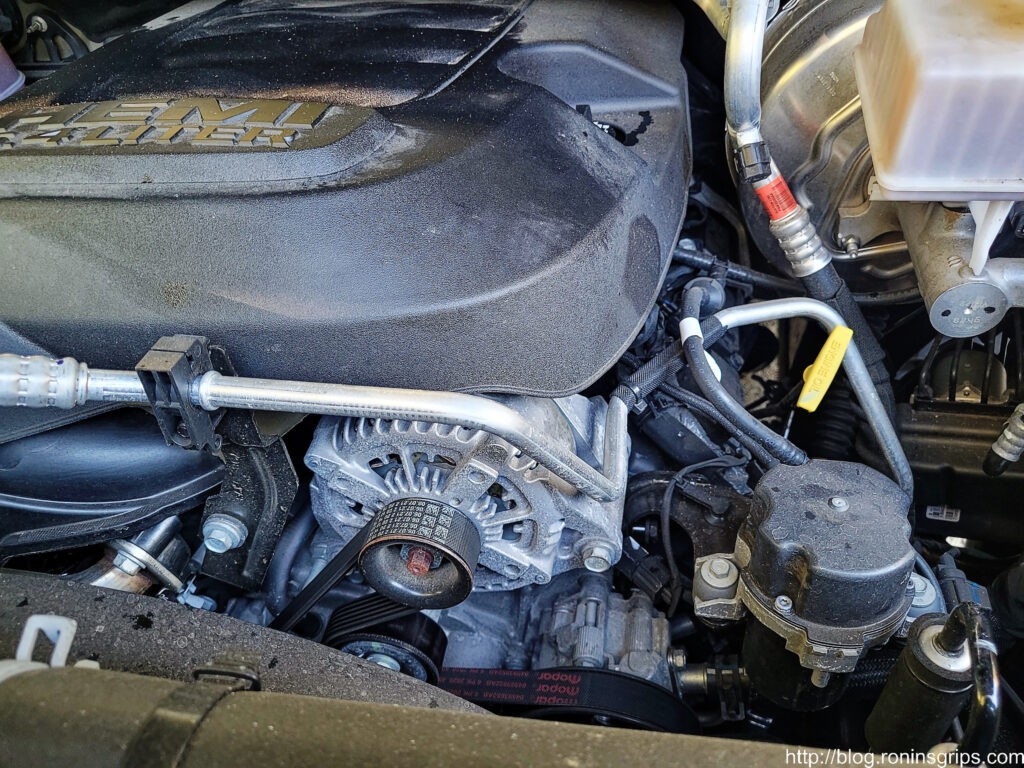
My point is that even with the bigger alternator, given that I am plowing, the RPMs are going up and down over and over plus I am never going very fast. Hmmm….. I usually was idling when I had the blower running and went to lift the plow. With an engine idle speed of 720 RPM (I just went out and got that from my ODB2 scanner), we’d get an alternator speed of 720 x 2.90 pulley ratio = 2,088 alternator RPM. Using the output chart that FCA has at 2,000 RPM the alternator is producing about 146.5 amps.
Hmmmm…. far less than the plow’s draw of 205amp let alone having the blower on high. I did some digging and while I couldn’t find an absolute number from Dodge, the range mentioned seems to be 15-20amps. I don’t often plow in the dark so I am not factoring in lights. Regardless, the alternator would not be producing enough amps so the demand would need to tap into the battery’s reserve but that wasn’t enough obviously.
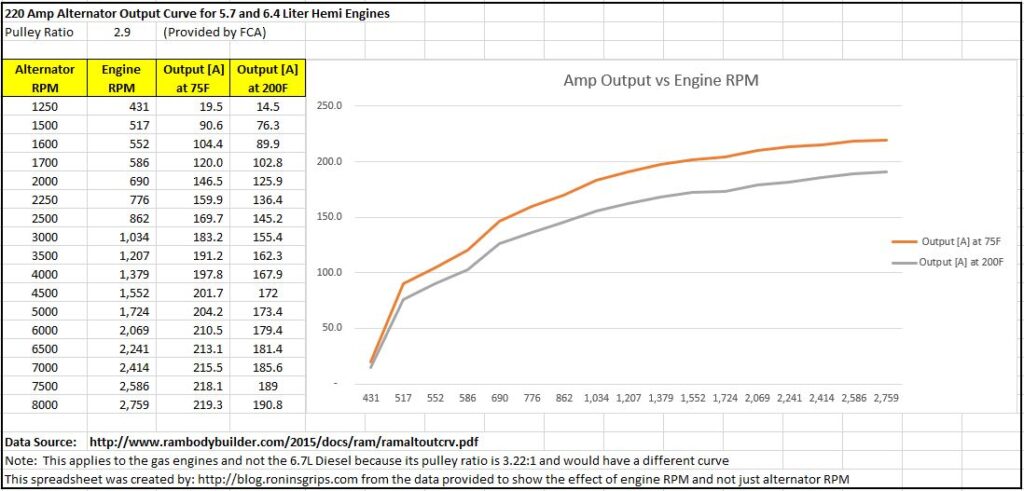
Quick comment: I did not know it but there is a dual alternator option for the Hemi-powered 2500. With two alternators, both are contributing amps even at lower RPMs. Had I known, I would have tried to negotiate adding this option in as part of the purchase and at least had it financed. Then again, it would have been a gamble to avoid this problem that I didn’t even know existed.
The Original 730 CCA Battery
Let’s now consider a second important element – The battery powers the starter to start the truck of course but it also serves as a reserve buffer to even out power delivery when there are surges in demand that the alternator is unable to cover. Dodge went mediocre here. Why they didn’t use a bigger battery or even dual batteries – I don’t know. Well, I do know – either they went cheap to make more money or the engineers didn’t have real world snow plowing experience or didn’t talk to any real snow plow owners. Sorry guys – I have to call it the way I see it.
The OEM (Original Equipment Manufacturer) battery that came with the truck brand new was only rated for 730 cold cranking amps (CCA). While that is enough to start a 6.4 liter Hemi and run the stock electronics, it would appear to not enough to compensate for a plow at lower RPMs – at least not my Western 8′ Pro Plow 2 anyways. A smaller plow would likely have lower power demands and conversely, a larger plow would likely have higher power demands.
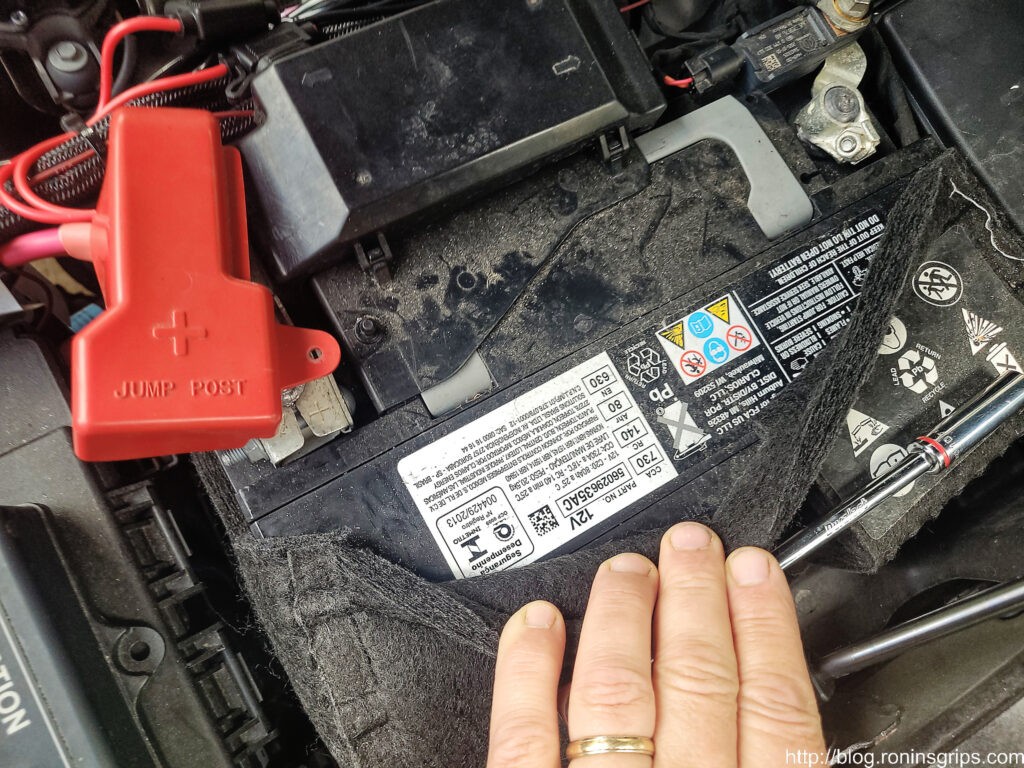
By the way, cold cranking amps identifies the battery’s potential amp output at 0 degrees Fahrenheit or -18 Celsius. They measure the output of the new battery for 30 seconds and it has to maintain at least 7.2 volts (technically it is 1.2 volts per cell of the battery).
Because I live in Michigan and it has Winter weather, CCA is what I care about. Cranking Amps (CA) is measured at freezing which is 32F or 0C and not really something that matters to me. I need more CCA both because of starting the big Hemi in the cold winter (the stock battery did fine at that) but also to support all of the electronics plus the plow’s hydraulic motor … and this is where the stock battery fell short.
What did I do?
Well, I couldn’t afford to add a second alternator and aftermarket second battery mounts in the engine compartment were expensive (unless I wanted to mount something underneath on the frame which I did not want to do). By the way, I actually bought and tried to test fit the passenger side battery tray for the Cummins diesel models and it will not fit due to the location of the computer/ECU on the fender wall and there wasn’t enough space between the air box and the engine coolant reservoir.
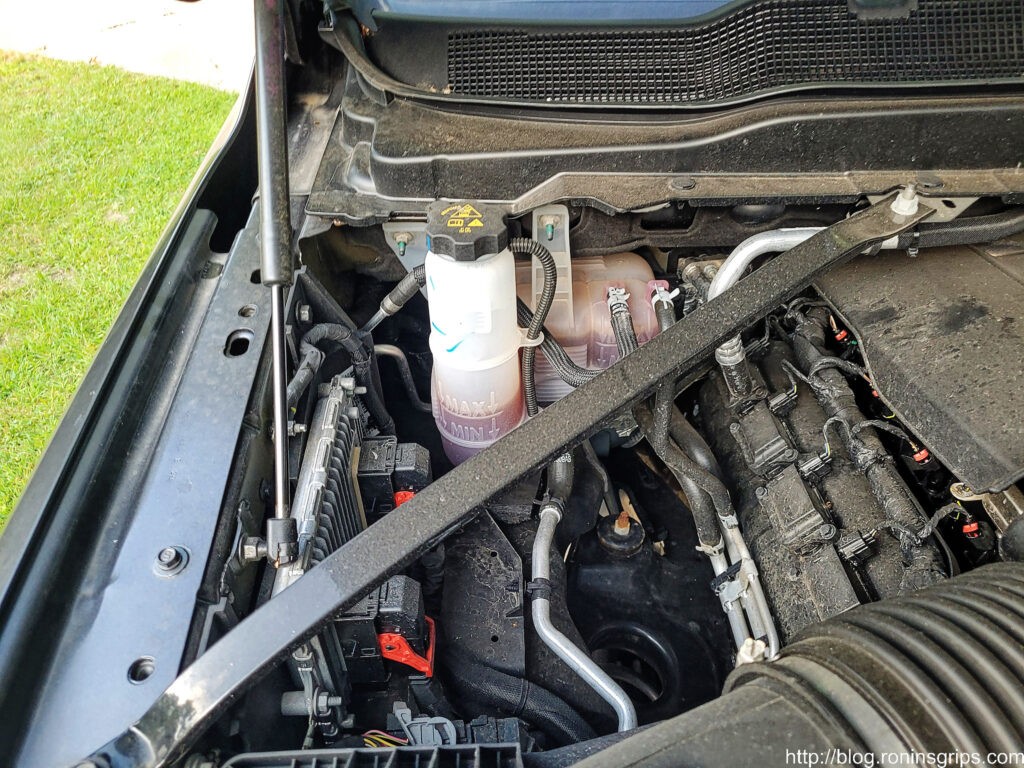
So, once I realized I couldn’t afford to add a second battery given my budget, I opted to buy the best AGM (Absorbed Glass Mat) battery I could find with the highest CCA rating in the H7 form factor. It also had to be affordable (sorry Optima – you’re too expensive).
I talked all of this over with my friend John – who is a professional mechanic with a ton of experience. He recommended that I go with an Interstate H7 size AGM battery. Now let me explain a bit more about why this was the case.
Starting with the brand, Interstate works with a number of manufacturers who actually build their batteries – namely Clarios and Exide. They are sold through a series of 200,000 dealers including Costco.
H7 relates to the shape of the battery that the RAM 2500 is designed to hold. An H7 measures 12-3/8″ x 6-7/8″ x7-1/2″ (315x175x190mm).
AGM is a relatively newer battery technology (it was invented in 1980) that can produce both higher CCA and reserve power compared to traditional flooded lead acid batteries of the same size. AGMs are still lead acid but there is a thin fiberglass matt sandwiched between the lead plates and they are bundled together. There are tons of websites out there with far more details on AGM where you can read more.
The Interstate AGM battery is rated at 850 CCA – almost 120 more than the OEM battery. That really sold me. I’ve used AGM batteries in the past and had very good luck with them so I had John pick one up for me the next time he visited Costco. Thanks to inflation, it was about $217 out the door.
Installing The New Battery
Okay, before you do anything else – make sure the battery you just bought is the same size and the terminals are still in the right place. Stuff happens. It’s better to find a mistaken purchase out before you do anything to your truck.
Modern vehicles have a ton of info in their computer and a lot of it disappears when the power is lost – either when your battery completely dies, or in our case, if the battery is disconnected. A lot of it will be re-learned as the computer communicates with the sensors and figures out what is normal. Now what all gets lost in the UConnect system after a power loss tends to get different answers. Let me just say I didn’t want to deal with any problems so what I did was power the computer (ECU) through the OBD2 port under the dash using a purpose built cable from VSTM and a Clore Automotive JNC660 jump pack. This combination provides electricity to the computer so none of your settings are lost – it makes changing a battery very straight forward.
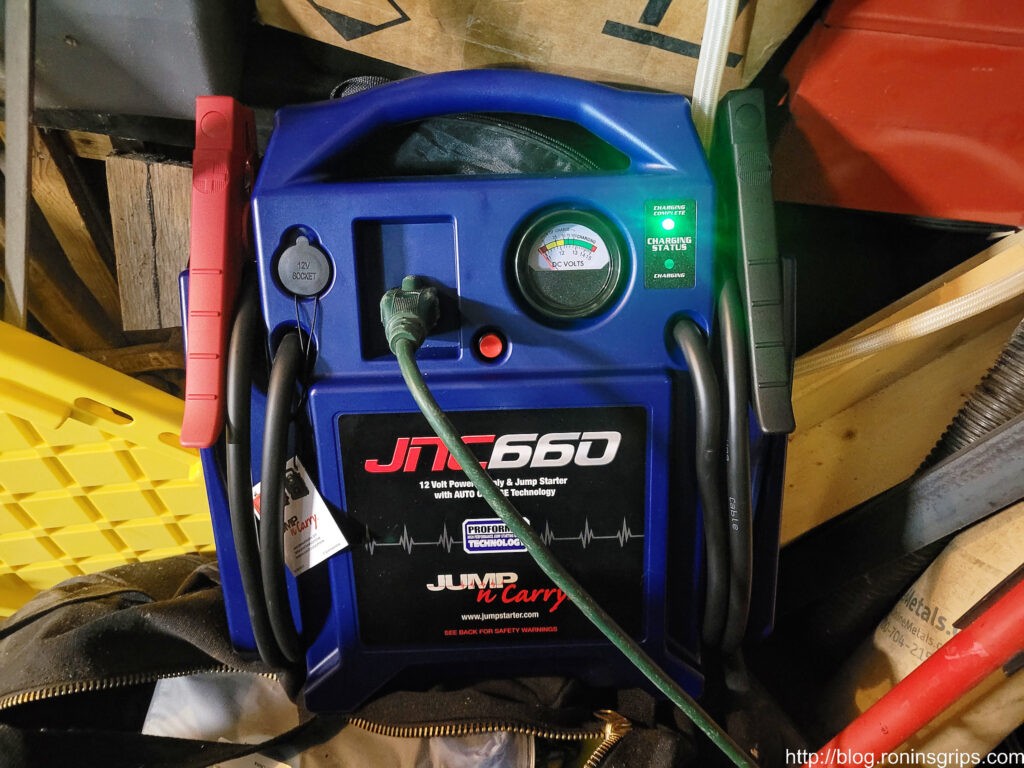
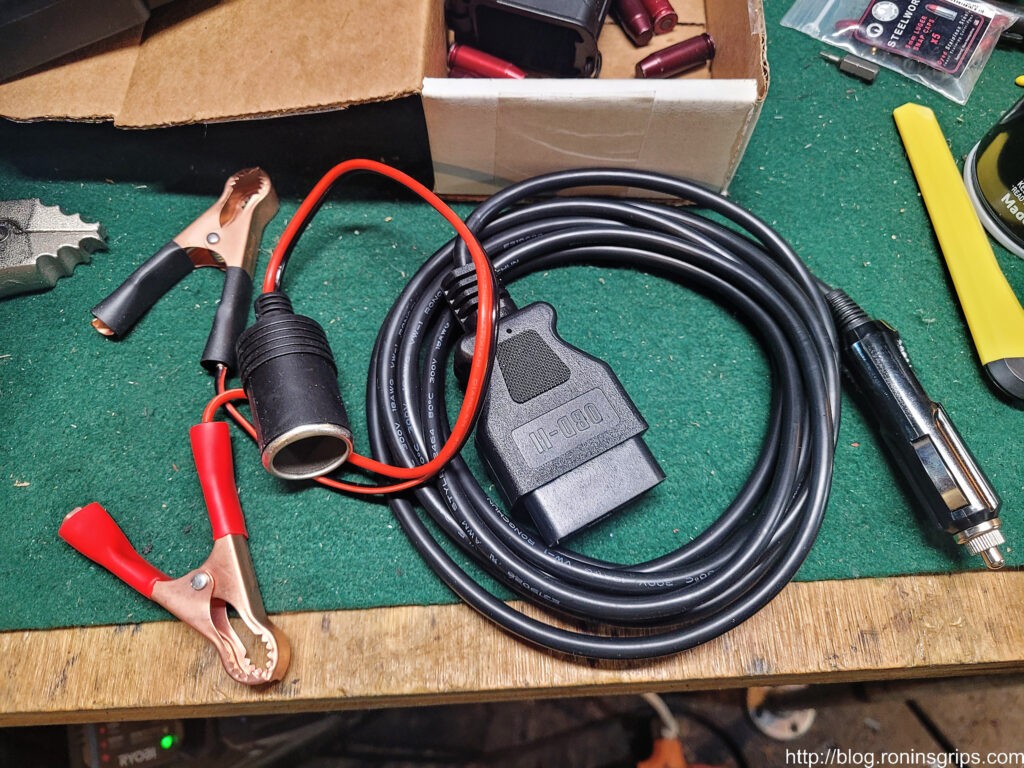
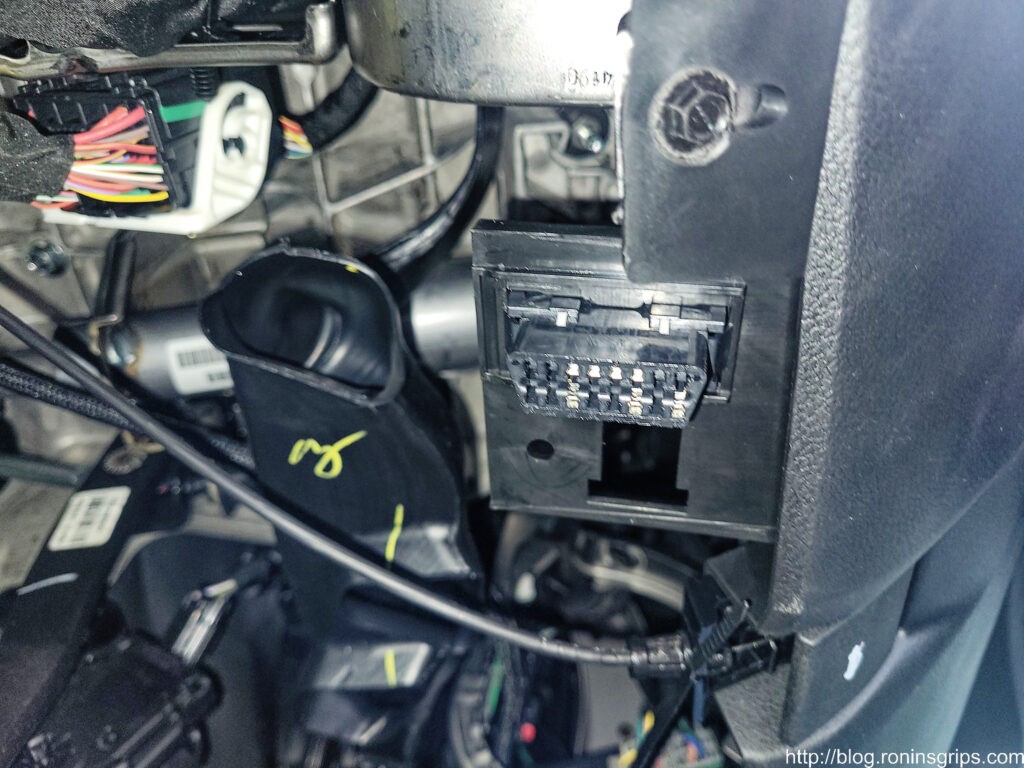
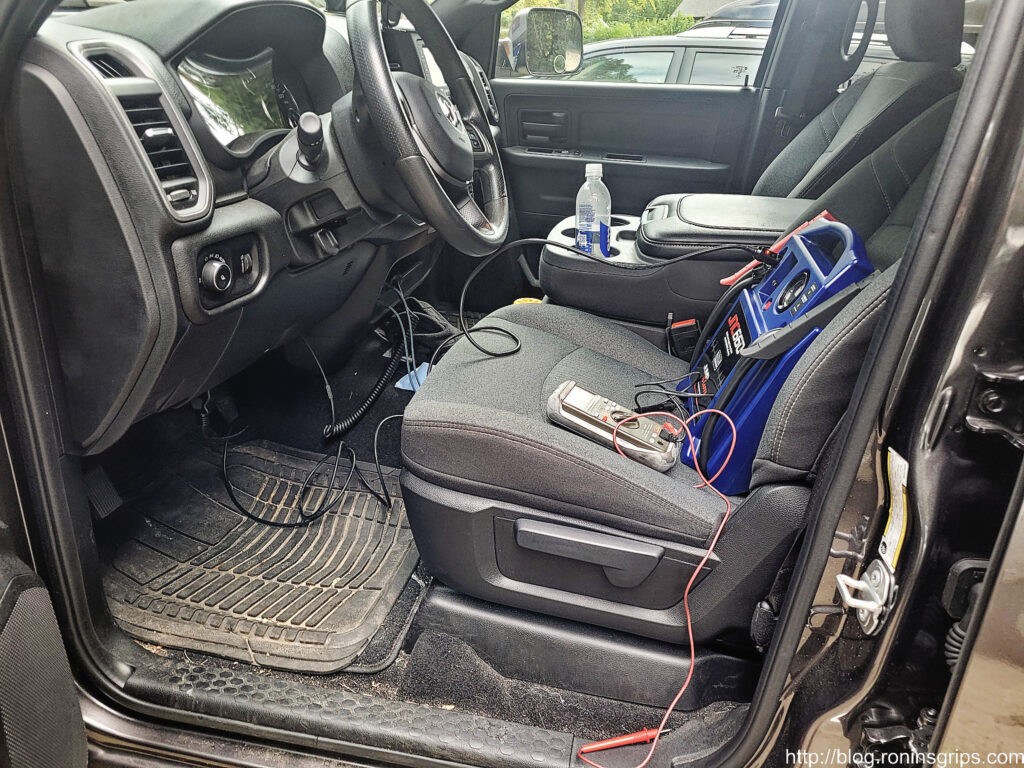
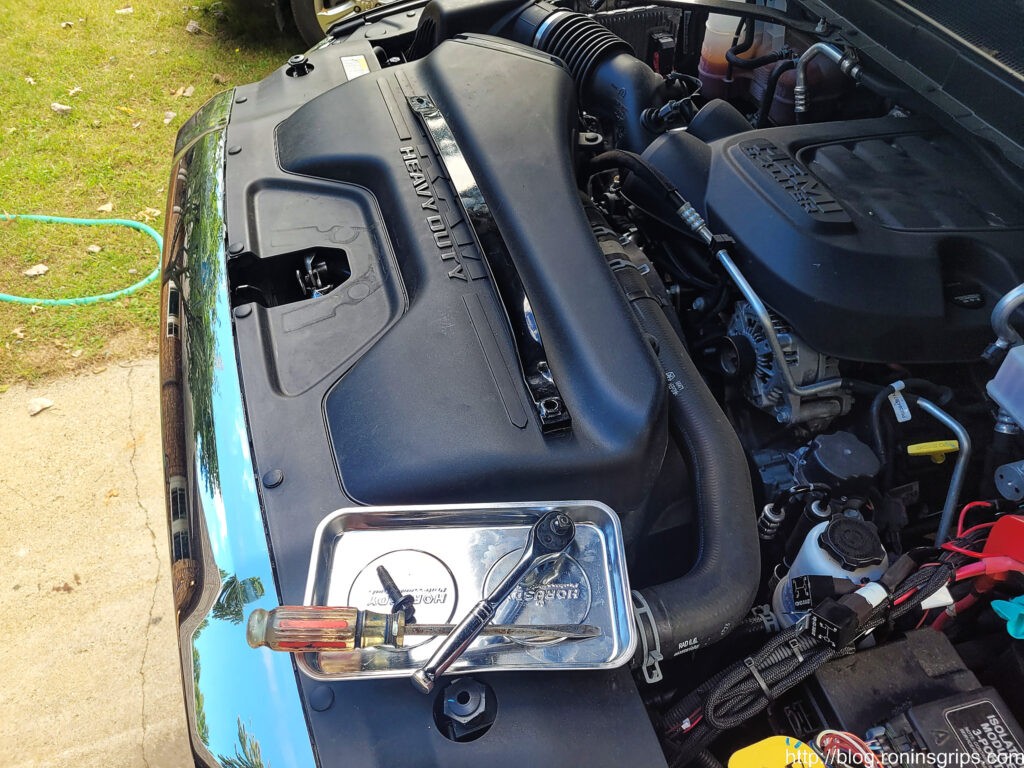
The next step was to disconnect the battery. I removed the negative terminal first and pushed it to the side. I disconnected the positive terminal assembly from the battery’s top post and covered it with a Nitrile glove. In most cars, and I am assuming it is the case with my truck, the powering of the computer through the OBD2 port also sends 12 volt power to the now-disconnected positive power cable and I did not want a surprise from something shorting. Cheap insurance in other words.
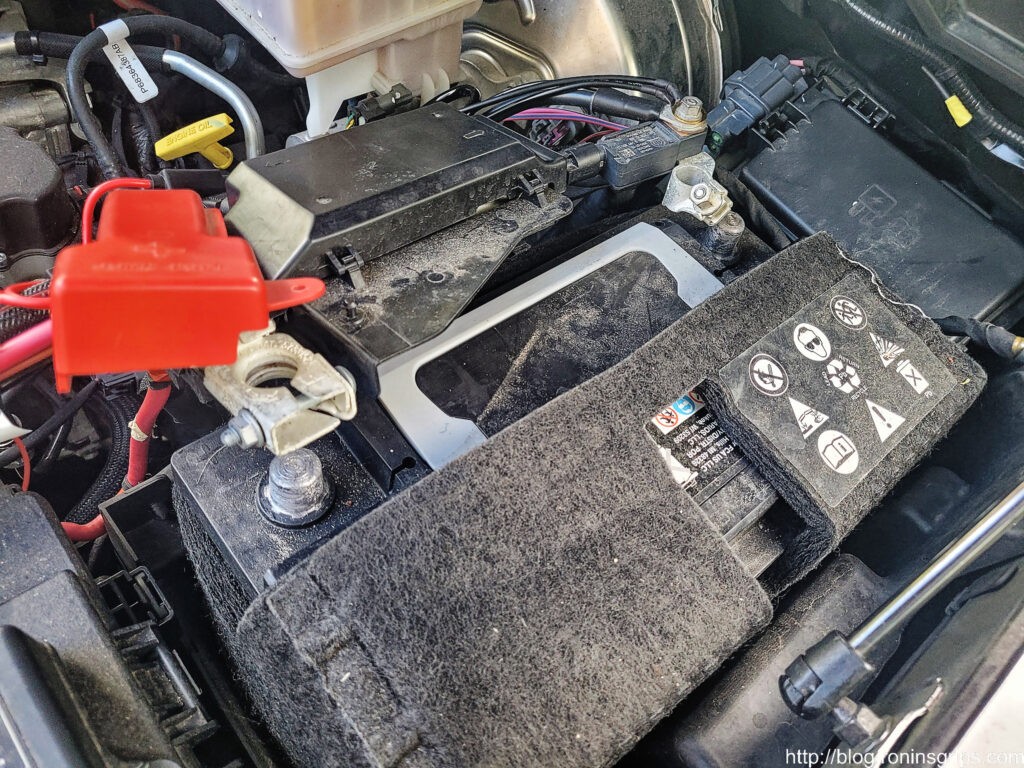
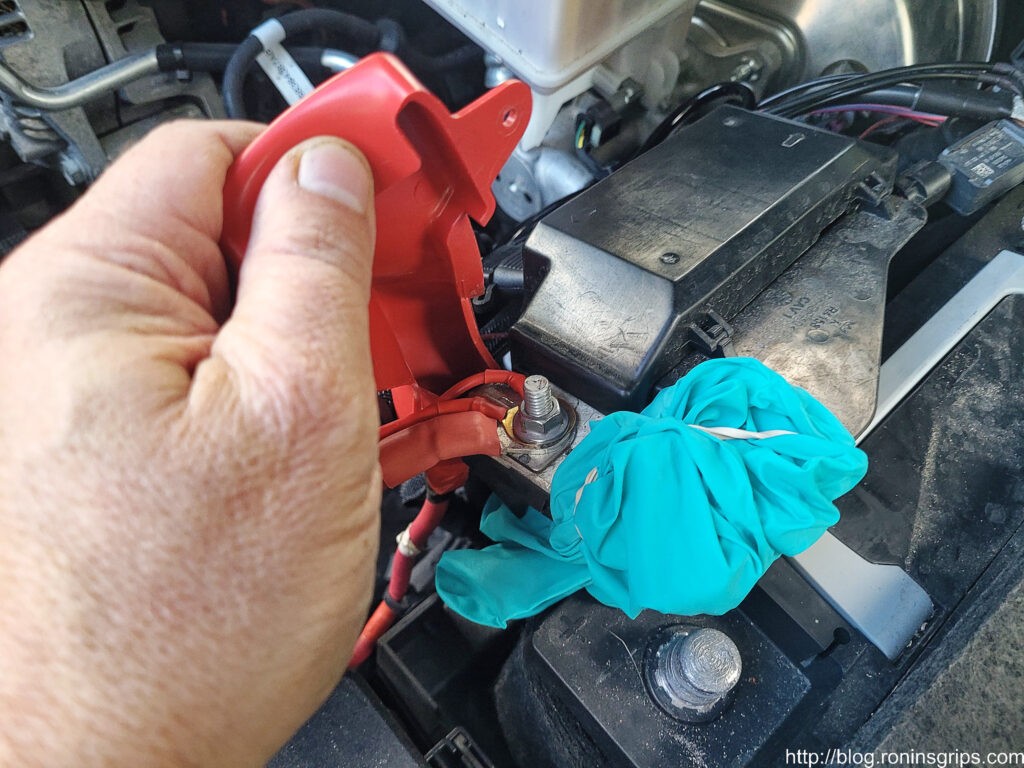
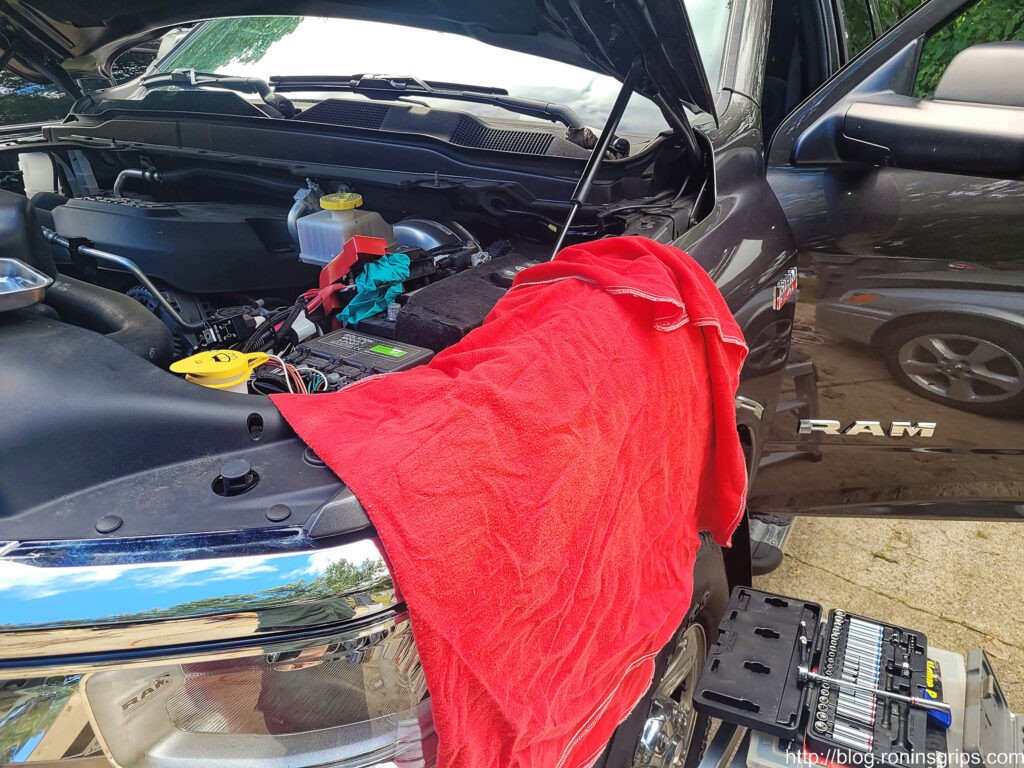
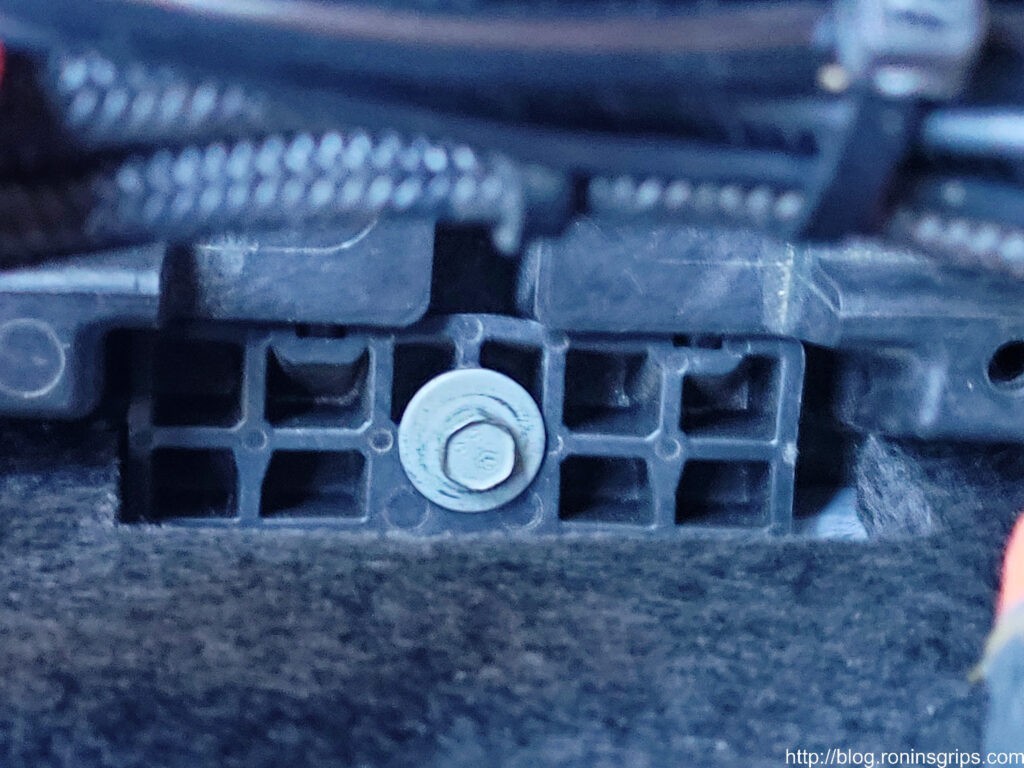
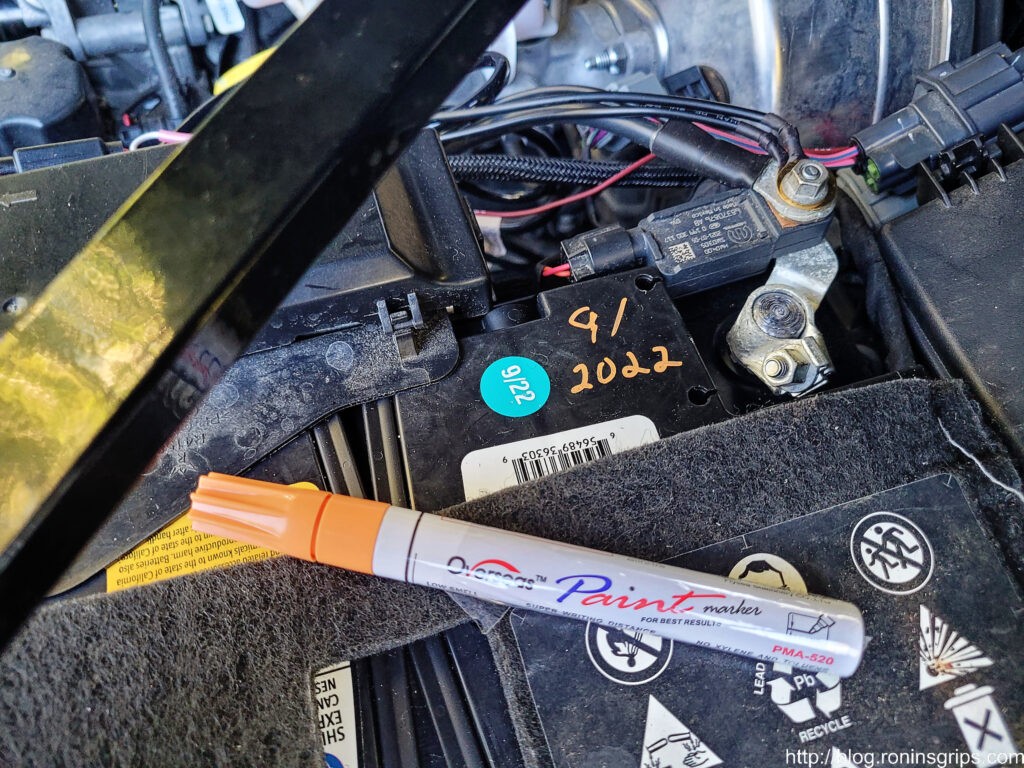
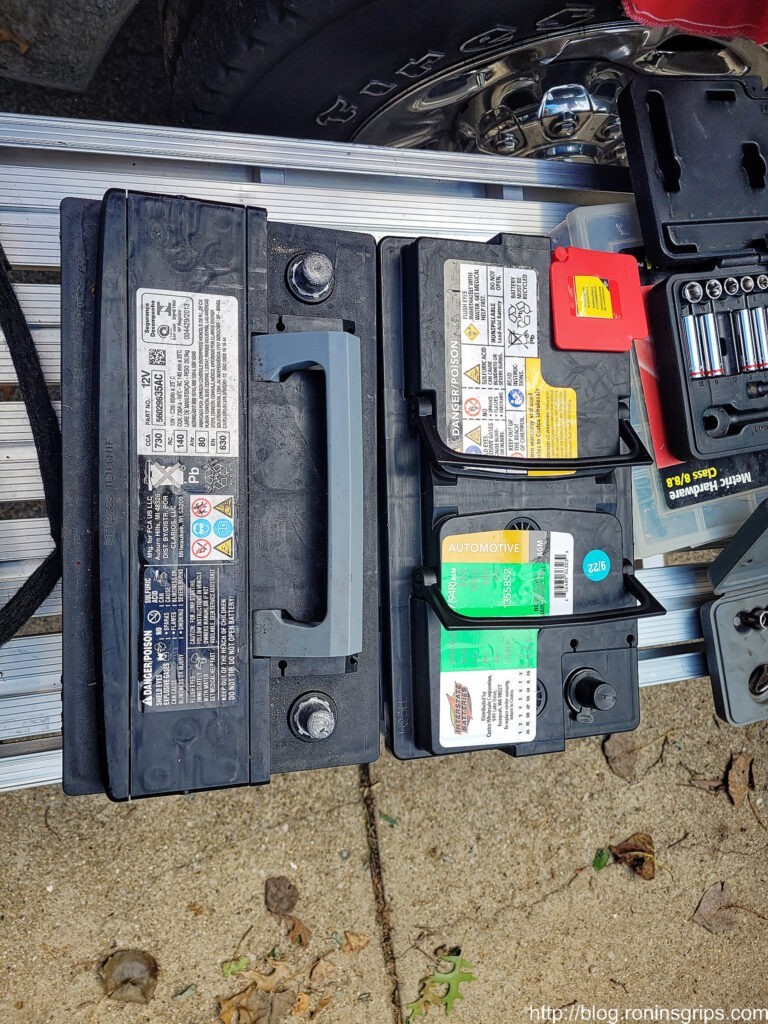
I did take the insulated jacket off the OEM battery and put it on the new Interstate AGM battery. It’s not necessarily to keep it warm – it protects it to some extent from high heat in the engine compartment as well.
Batteries are heavy. Make sure you have a step or something so you can line things up and protect your fender. Installing the new battery is just a reverse of what I listed. Re-install the clamp, the positive side terminal, the negative side terminal and then the reinforcing strut.
Be sure to remove the ODB2 power cord at this point. The battery tested over 12 volts so I turned on the ignition and everything seemed to work – the truck started, ran fine, all of my phone settings and stored Sirius XM stations were there, etc.
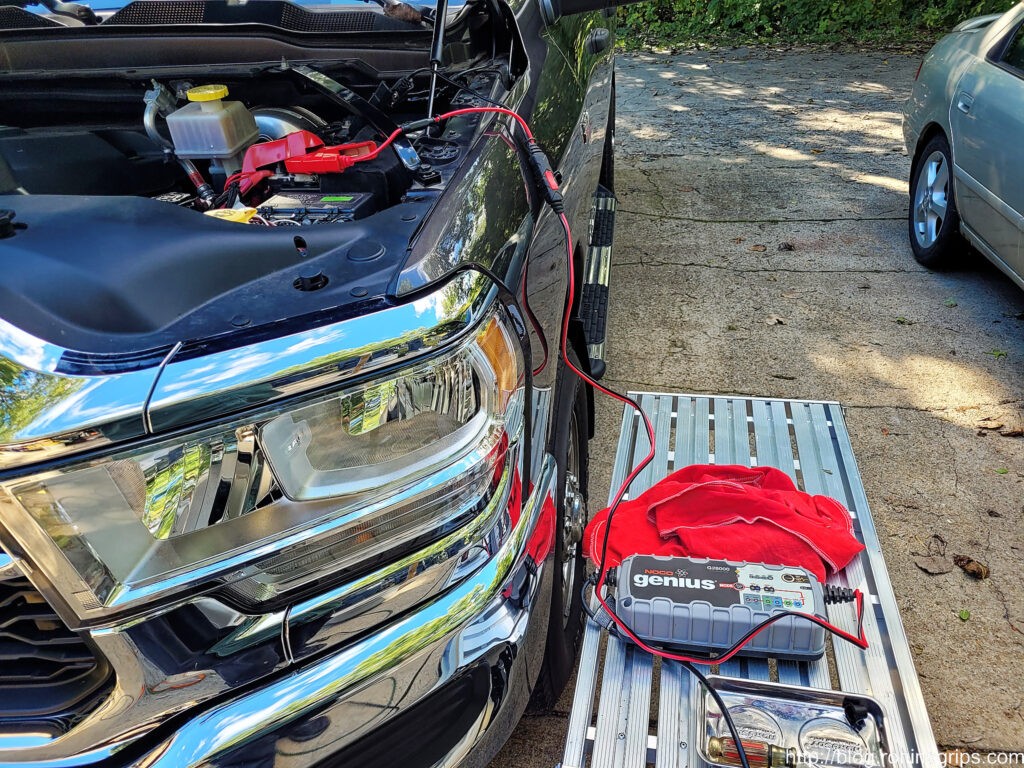
Truck & Plow Testing
Starting the truck and running the base electronics are one thing but could it actually support the plow better? Now that was the big expensive question. I sure hoped it would.
For the first time this fall, I hooked up the big plow, lifted it up and brought it over to the driveway. The fact the truck could lift the plow was the first promising sign.
I tested the truck and plow three ways and did short videos of each:
Battery Testing Via Foxwell BT705
The company that actually makes the OEM battery for FCA/Dodge is Clarios. They were a spin off from Johnson Controls and were bought by Brookfield Business Partners, an equity firm, in 2019. My point is that they know how to make batteries and also point out on their website that 1 in 3 cars on the road are running a battery made by them.
The reason I am bringing the lineage up is that the shortcoming is not their fault or something defective during the manufacture of the actual battery in my truck. The factory battery label claims 730 CCA and in testing with my Foxwell BT705 with the temperature at 46F, it delivered 760 CCA and this is despite being out of the truck without any charging for 7 days. No, the battery was just fine in terms of hitting its declared specification but Dodge should have put a bigger one in.
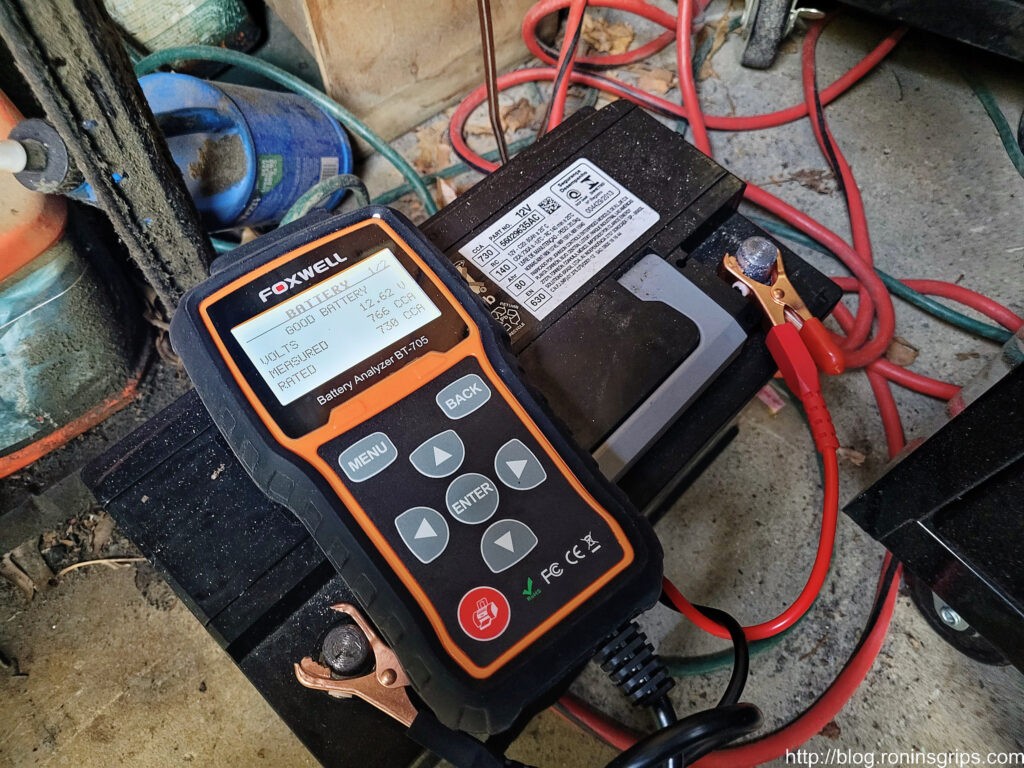
In terms of the Interstate, whew. It is packing some amps. The label claims 850 CCA and the digital BT705 meter is reporting 883 CCA. That is 133 amps more than the flooded lead acid OEM battery. The truck hasn’t been used for over 24 hours – closer to 36 if I were to estimate it – so no last minute charging there either. The temperature was still 46F so neither battery was tested at 0F just to be clear.
By the way, I’ve owned the BT705 battery tester since January 2018 and have found it to be quite reliable. The tester gets great scores on Amazon and I have never had it tell me that a battery was ok that then failed. This matters to be a lot in the Winter as I don’t want family or friends getting stranded with a dead battery.
Test Conclusion
Based on the tests conducted above, the Interstate AGM battery provides enough of a buffer that the problem appears to be fixed. There is one variable though and that is the temperature. You can see from the dash that it was 61F when I did these tests. When I plow it might be anywhere from 0 to 40F. In general, the colder a battery is, the less output it will have. I still have the Interstate’s higher 850 CCA (measured at 0F) to make me hopeful but winter will be the real test. I can hope, right? If I were to bet though, I bet the shedding problem is solved because real world I will not be running all of those accessories at once either.
It’s Not A Perfect Solution — AGM Batteries Still Have Limits
I do need to make one thing very clear – a battery is a buffer. If you are using power faster than the battery can be charged, then eventually load shedding will happen. Think of water behind a dam. If the water goes out slowly or once in a while and the reservoir can refill, everything is good. In contrast, if you use the water too fast or for too long, the reservoir will empty and there will be little to no water running from the dam. Same idea.
An AGM battery contains quite a bit of reserve power and can sustain higher loads longer than a flooded lead acid battery designed for starting and lights. Even an AGM has limits though
I tend to do a bit of plowing and then drive. A bit of plowing and then drive. If you are doing a ton of plowing before the alternator can replenish the battery sufficiently then shedding will still happen. You will then need to decide if you add battery capacity via a second battery or invest in a dual alternator set up. One trick is to hook up a battery charger – I like Noco Genius smart chargers – to fully charge your battery over night if need be. It all comes down to how much you plow and how long the alternator has to catch up.
Summary
Let’s wrap this post up. Despite Dodge’s claim that the Snow Chief package makes a 2500 truck plow ready, that is not necessarily the case. It would appear that the single 220 amp alternator running at realistic engine speeds during plowing will not produce enough amps to support the plow and the blower motor. In addition, the original battery doesn’t provide enough buffer to temporarily compensate either for the lack of alternator output relative to demand.
There is no indication that anything is defective – let me be clear on that. Instead, these are design issues and should not have surprised anyone. Plows have been around for decades. The dealership who sold me the truck and the plow, not to mention the installers they contracted with, should have known whether there would be an issue or not but nobody raised a flag and said “stop” or “hey, just so you know – you can’t run your blower motor on high and raise your plow at the same time.”
Given the test results of placing a full load on the combination of the original 220 amp alternator and new Interstate AGM battery, it would seem that the load shedding problem has been solved. While the temperature during testing was 61F and thus 30-60 degrees higher than what would be encountered during my typical plowing work, the higher CCA rating of the new battery and the likely load on the battery during real use being lower, the probability is quite high that the problem is fixed. That’s a mouth full.
If you are having problems with load shedding, your first least expensive option is to go get a good AGM battery from a reputable dealer with as high of a CCA rating as you can get for the size battery your truck uses – again, my 2021 Ram 2500 Tradesman with the 6.7L Hemi uses an H7 size battery.
I’ll post updates after I actually use the plow in the Winter but I’m betting the problem is fixed. $50 says I never hear a peep from Dodge about fixing this, paying for the battery or even just providing any further insight. So, for all of you folks that snowplow and have a Ram 2500, I hope this helps you out.
01/21/2024 Update: Well, winter hit us hard this past week. Temperatures in the single digits and pushing 20″ of snow not including drifts. The truck is working like a champ – I can plow with the blower on whatever and no shedding happens. I can definitely say now that the AGM battery fixed the problem. Still not thrilled with what Dodge did but then again, the 2500 and 8′ plow are doing an amazing job. I’m very happy. If you’re reading this and are experiencing shedding, get a solid AGM battery such as the Interstate I bought, and it will fix the problem.
12/27/2022: It was 19F and I was plowing about 8-12″ of snow in places. Defrost was on high and my regular plow (halogen) lights were running. I could hear the defrost slow down when I lifted the plow but the computer never shut off the blower. I still wish a better alternator or pair of alternators had been used but the AGM battery seems to have solved my problem.
Note, I have to buy all of my parts – nothing here was paid for by sponsors, etc. I do make a small amount if you click on an ad and buy something but that is it. You’re getting my real opinion on stuff.
If you find this post useful, please share the link on Facebook, with your friends, etc. Your support is much appreciated and if you have any feedback, please email me at in**@*********ps.com. Please note that for links to other websites, we are only paid if there is an affiliate program such as Avantlink, Impact, Amazon and eBay and only if you purchase something. If you’d like to directly contribute towards our continued reporting, please visit our funding page.
